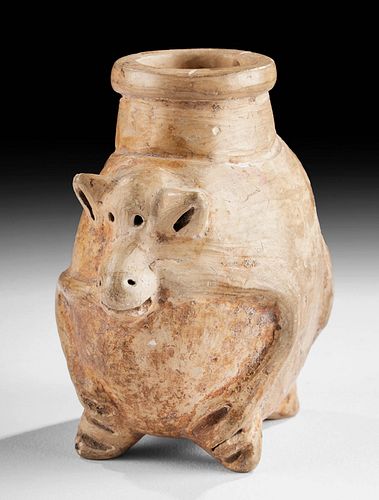Maya Pottery Poison Jar - Monkey Form
Lot 155
About Seller
Artemis Fine Arts
686 S Taylor Ave, Ste 106
Louisville, CO 80027
United States
Selling antiquities, ancient and ethnographic art online since 1993, Artemis Gallery specializes in Classical Antiquities (Egyptian, Greek, Roman, Near Eastern), Asian, Pre-Columbian, African / Tribal / Oceanographic art. Our extensive inventory includes pottery, stone, metal, wood, glass and textil...Read more
Categories
Estimate:
$700 - $1,050
Absentee vs Live bid
Two ways to bid:
- Leave a max absentee bid and the platform will bid on your behalf up to your maximum bid during the live auction.
- Bid live during the auction and your bids will be submitted real-time to the auctioneer.
Bid Increments
| Price | Bid Increment |
|---|---|
| $0 | $25 |
| $300 | $50 |
| $1,000 | $100 |
| $2,000 | $250 |
| $5,000 | $500 |
| $10,000 | $1,000 |
| $20,000 | $2,500 |
| $50,000 | $5,000 |
| $100,000 | $10,000 |
| $200,000 | $20,000 |
About Auction
By Artemis Fine Arts
Jul 22, 2021
Set Reminder
2021-07-22 10:00:00
2021-07-22 10:00:00
America/New_York
Bidsquare
Bidsquare : Summer Antiquities & Ethnographic Art Auction
https://www.bidsquare.com/auctions/artemis-gallery/summer-antiquities-ethnographic-art-auction-7245
Travel around the world and back in time...and be amazed at the treasures you will find! Antiquities from Egypt, Greece, Italy and the Near East, Asian, Pre-Columbian, African / Tribal / Oceanic, Native American, Spanish Colonial, Russian Icons, Fossils, Fine Art, much more! Artemis Fine Arts info@artemisgallery.com
Travel around the world and back in time...and be amazed at the treasures you will find! Antiquities from Egypt, Greece, Italy and the Near East, Asian, Pre-Columbian, African / Tribal / Oceanic, Native American, Spanish Colonial, Russian Icons, Fossils, Fine Art, much more! Artemis Fine Arts info@artemisgallery.com
- Lot Description
Pre-Columbian, Southern Mexico to Guatemala, Maya, Late Classic Period, ca. 550 to 900 CE. A lovely mold-formed pottery "poison jar" in the form of an adorable monkey. The round-bottomed jar is supported by a quartet of triangular feet, has a rounded shoulder with a squat neck, and a thick rim on top. The abstract simian features include a simple head on the front, sinuous arms and legs on either end, and a perky tail protruding from the verso. The highly burnished jar is covered in cream-hued slip that imbues it with an elegant presentation. Size: 3.375" L x 1.8" W x 2.875" H (8.6 cm x 4.6 cm x 7.3 cm).
The Maya Classic phase is so named because it was the peak of their artistic and cultural achievements. Part of this, as in many societies, included highly specialized consumable goods. Elaborate vessels like this one were designed to be instantly distinguishable from those used for everyday eating or drinking - not just in decoration, but also in quantity produced, making these a much rarer find than your average piece of domestic pottery. They were also made to be for only a single, specific function - in this case, to hold something valuable. Traditionally, items like this one have been known as "poison" or "medicine" bottles, in part because of their comparison to bottles used by other native North American groups, but depictions of people using the flasks in artwork as well as residue analysis on archaeological examples suggest that they may have had other uses. They are often found in the context of burials, filled with red pigment like cinnabar or hematite, but with the remains of other things underneath the pigment (as if they were used in life and then filled with pigment upon death). Because of their size, they must have been made to contain things not required in large quantities - indeed, poisons or medicines, but also perfume, tobacco, and ritual drugs like powdered mushrooms.
Provenance: ex-Merrin Gallery, New York, New York, USA; ex-private New York, USA collection, acquired in the 1960s
All items legal to buy/sell under U.S. Statute covering cultural patrimony Code 2600, CHAPTER 14, and are guaranteed to be as described or your money back.
A Certificate of Authenticity will accompany all winning bids.
PLEASE NOTE: Due to recent increases of shipments being seized by Australian & German customs (even for items with pre-UNESCO provenance), we will no longer ship most antiquities and ancient Chinese art to Australia & Germany. For categories of items that are acceptable to ship to Australia, please contact us directly or work with your local customs brokerage firm.
#148177Minor abrasions to rim, body, and simian features, with light fading to original pigmentation, and minor encrustations within body, otherwise intact and very good. Light earthen deposits and great traces of original pigment throughout.Condition
- Shipping Info
-
All shipping is handled in-house for your convenience. Your invoice from Artemis Gallery will include shipping calculation instructions. If in doubt, please inquire BEFORE bidding for estimated shipping costs for individual items.
-
- Buyer's Premium



 EUR
EUR CAD
CAD AUD
AUD GBP
GBP MXN
MXN HKD
HKD CNY
CNY MYR
MYR SEK
SEK SGD
SGD CHF
CHF THB
THB















